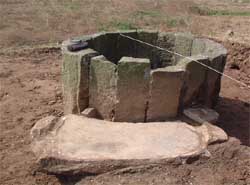
There are about 13 ancient salt well, which are found at Zhongba site
Being critical in the development of the human civilization, the ancient salt-making has been an important research issue for historians and archaeologists. Since salt dissolves in water, it is difficult to tell whether the salt in archaeological samples was caused by salt production or underground water. So how to judge the existence of salt production has been a world-wide problem in archaeology and archaeometry.
Most people think that China's salt production started in Sichuan, but scientific evidence to support this conclusion has not been got yet. Recently, Prof. Wang Changsui from the Graduate University of CAS and his former doctoral student Zhu Jiping in University of Science and Technology of China, in cooperation with archaeologists from Harvard University, California University at Los Angeles and several Chinese institutions, provided strong scientific evidence that showed earliest salt production activity in Zhongba in Sichuan Province, central China at least 3,000 years ago. Their work was reported in the August 30 issue of the
Proceedings of the National Academy of Sciences (PNAS).
In late 1990s Prof. Wang and Dr. Zhu employed many scientific approaches such as X-ray diffraction (XRD) and scanning electron microscopy (SEM) to examine the sherds of the round-bottomed pottery from the Zhongba site. The XRD analysis showed that phase composition of the residues on the sherds was consistent with those on a 2,000-year-old salt-boiling pan found in Zigong city and residues of making salt from a modern salt production factory in Yunyang, Sichuan. And both Na and Cl concentrations were highest on their interior surface and there was a clear gradient toward lower concentrations toward the exterior of the sherds through SEM examination on the walls of sherds of the ceramics. However, the salinity was absent in their exterior surfaces. The results ruled out of the possibilities that the salinity came from underground water and showed it was from a salt making.
Combined with other archaeological evidences, the researchers concluded that salt production was the most significant activity at Zhongba during the first millennium B.C. and that the production might have been significant in the area 1,000 years earlier. It is believed to be the earliest salt-making workshops in the world so far.
This work provides an early example of salt production discovered in China and presents a methodology for evaluating salt production sites in other regions, says Dr. Rowan Flad, an archeologist from Harvard University and lead author of the article.





